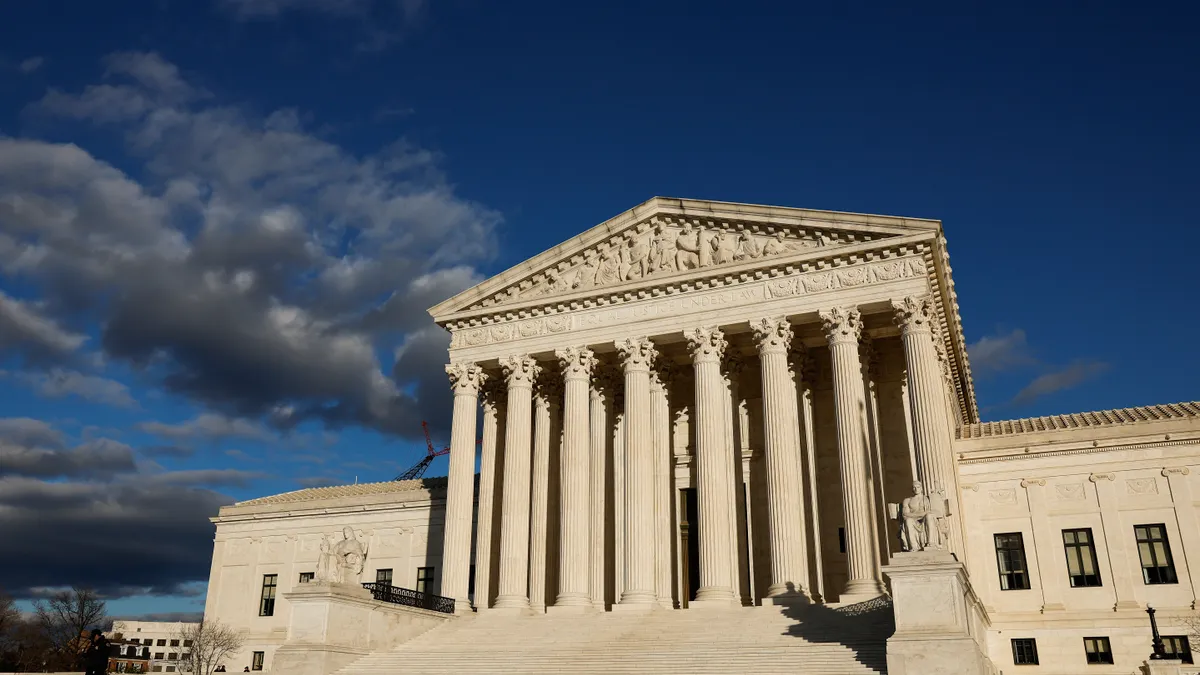Dive Brief:
- The Supreme Court on Friday struck down its so-called Chevron test that gave deference to a government agency’s expertise when a law is ambiguous.
- “Agencies have no special competence in resolving statutory ambiguities. Courts do,” wrote Chief Justice John Roberts for the majority.
- The ruling represents a sea change for a wide range of agencies along with the industries that they regulate. The Court’s 1984 ruling in Chevron v. Natural Resource Defense Council had been one of the most influential decisions in recent decades.
Dive Insight:
The Supreme Court’s sweeping 6-3 decision in Loper Bright Enterprises v. Raimondo finds that courts need not defer to a federal agency’s interpretation of the law simply because the statute the agency administers may have gaps or be unclear.
The dispute involved a pair of cases involving a National Marine Fisheries Service rule requiring companies to pay the costs of hosting federal agents on their boats to curb over-fishing. The agency said the companies should bear the costs.
At the heart of the issue was the Chevron test, which stated that whenever a statutory provision is silent or ambiguous, deference should be given to the agency’s interpretation as long as it is reasonable.
Writing for the majority, Chief Justice Roberts said, “Chevron has proved to be fundamentally misguided.” He added that the deference to agencies that Chevron requires cannot be squared with the Administrative Procedure Act. The Court’s five other conservative members joined the Chief Justice’s opinion.
The decision vacates a pair of lower court rulings that had left the decision about whether the government or the companies should pay the cost of the monitors to the National Marine Fisheries Service.
Writing for the dissenters, Justice Elena Kagan noted that judges are not scientific or technical experts and that agencies often know things about a statute’s subject matter that courts could not dream of.
“The majority has turned itself into the country’s administrative czar,” she wrote in observing that the decision gives courts the power to make policy calls on issues such as climate change, workplace safety and countless others.
“The Supreme Court’s decision opens the floodgates to litigation that will erode critical protections for people and the environment,” said the director of the Ocean Conservancy’s Fish Conservation Program, Meredith Moore, in a statement.
But Daniel Wolff, who leads the administrative law litigation team at Crowell and Moring in Washington, D.C., told Legal Dive that the Supreme Court’s ruling does not mean the end of the administrative state.
“It obviously affects the amount of deference agencies will get from the federal courts, but it’s not like democracy is ending because we don’t have Chevron deference,” Wolff said. “They [agencies] can still regulate. They just have to do it within the confines of their statutory authority.”
Wolff said that the business community will like the ruling but added, “We won’t necessarily get fewer regulations — just better regulations.”
He also noted that the courts had already pared back agency authority to a degree. Along similar lines, Chief Justice Roberts pointed out the Supreme Court had not deferred to an agency interpretation under Chevron since 2016. However, the decision has been cited at least 17,000 times in the lower courts during the last 40 years.
Environmental lawyer Michael Drysdale, of Dorsey and Whitney, suggested the impact of the ruling cannot be overstated because of what it means for the scope of agency regulatory authority. “There were sexier decisions issued at the end of the Supreme Court’s term, but the one with the most far-reaching implications may be Loper Bright Enterprises v. Raimondo,” said Drysdale.
On the labor and employment law front, Seyfarth Shaw LLP Senior Counsel Rachel See acknowledged that “the death of Chevron deference is a big deal and the decision upends a very complex body of law.”
But for labor and employment lawyers contemplating how NLRB and EEOC will change as a result of this decision, See said, “The short answer is that courts haven’t been giving Chevron deference to the EEOC or NLRB in the first place.”
The ruling came down just 24 hours after the Supreme Court struck down the Securities and Exchange Commission’s in-house system for deciding civil fraud penalties in SEC v. Jarkesy. It’s a connection Justice Kagan was quick to make at the end of her dissent in writing, “It is impossible to pretend that today’s decision is a one-off.” She went on to call Loper “another example of the Court’s resolve to roll back agency authority, despite congressional direction to the contrary.”












